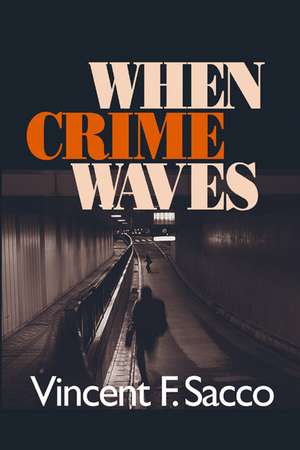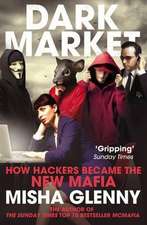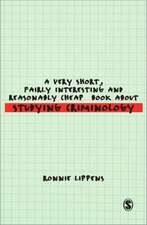When Crime Waves
Autor Vincent F. Saccoen Limba Engleză Paperback – 30 iun 2005
Key Features:
The only book to critically examine the phenomenon of crime waves in an engaging fashion for undergraduate students.
Historical and contemporary examples drawn primarily from the U.S. International examples will be threaded thoughout the book for a comparative perspective.
Examines the role media and politicians play in creating the perception that a crime wave has occurred.
Preț: 551.83 lei
Preț vechi: 649.20 lei
-15% Nou
105.60€ • 109.63$ • 88.06£
Carte tipărită la comandă
Livrare economică 24 martie-07 aprilie
Specificații
ISBN-10: 0761927832
Pagini: 224
Dimensiuni: 152 x 229 x 12 mm
Greutate: 0.31 kg
Ediția:1
Editura: SAGE Publications
Colecția Sage Publications, Inc
Locul publicării:Thousand Oaks, United States
Recenzii
Cuprins
Acknowledgements
Chapter 1: What are Crime Waves?
Defining Crime Waves
Social Constructionism
The Criminal Content of Crime Waves
The Nature of Waves
Some Uses of Crime Waves
Conclusion
Chapter 2: Why do Crime Rates go Up and Down? Dislocation, Diffusion and Innovation
The Demography of Offending
Social Dislocations
Diffusion
Innovation
Conclusion
Chapter 3: Crime Waves by the Numbers
Numerate and Innumerate Consumers
The Statistics of Crime Waves
Statistics in the Raw
Emergent Problems
Statistical Record Keeping as a Social Process
Statistics in the Media
Conclusion
Chapter 4: Mass Media and Crime Waves
Importance of Crime to Mass Media
How Do the News Media Cover Crime?
Why Do Media Cover Crime as They Do?
How Do Media Generate Crime Waves?
Conclusion
Chapter 5: That's the Rumor
Talking About Crime
Rumors and Legends
The Rumor Process
The Social Implications of Talk
Conclusion
Chapter 6: Being Afraid
The Meaning of Fear
What Are We Afraid Of?
Who Is Afraid?
Do Rising Crime Levels Cause Fear?
Does Fear Cause Rising Crime Levels?
The (Ir)rationality of Fear
When Fear Goes Wild
Conclusion
Chapter 7: Crime Waves and Public Policy
The Political Context
We're Going to War
Policy and Problem Image
Searching for the Panacea
When Social Control Becomes the Problem
Conclusion
Chapter 8: Crime Waves: A Skeptic's Guide
Are Crime Rates Really Going Up?
What Causes the Sudden Shifts in Crime Levels?
Can We Really Trust Crime Statistics?
Are My Own Experiences (And Those of My Friends) A Useful Guide as to Whether Crime Levels Are Increasing?
What Are We to Make of the Media Obsession With Crime?
These Stories I Have Been Hearing From so Many People Have to be True, Don't They?
The Fear of Crime is Irrational, Right?
It's Fear that Drives the Justice System Response, Isn't It?
A Rising Crime Level is A Simple Problem with A Simple Solution, Right?
When Interventions are Followed By Falling Crime Levels, Can We Assume Cause and Effect?
References
Index
About the Author
Notă biografică
Vince Sacco is a professor in the department of sociology at Queen¿s University in Kingston, Ontario. His research interests are in criminology and urban sociology. His interests relate to the study of criminology, as well as the study of public perceptions of and reactions to crime. In approaching criminology, his work emphasizes the study of "criminal events" and investigates why some people rather than others are more likely to be victimized by crime; when and where crimes occur; and why the police, lawmakers and members of the general public think about crime as they do. He has published several books including The Criminal Event 2/e Wadsworth, 2002, Advances in Criminological Theory (The Process & Structure of Crime: Criminal Events & Crime Analysis) Transaction Press, 2001, (with R.F. Meier and L.W. Kennedy), Crime Victims in Context, Roxbury Publishing, 1998, (with L.W. Kennedy).
.
Descriere
offers an in-depth exploration of a large number of social issues involved in the study of crime waves. Issues such as how and why crime rates change over time, why some types of crime and not others come in waves, and the role played by the mass media, politicians, and interest group leaders in the promotion of crime waves are discussed to help students develop analytical skills and apply them to real-world situations.

















